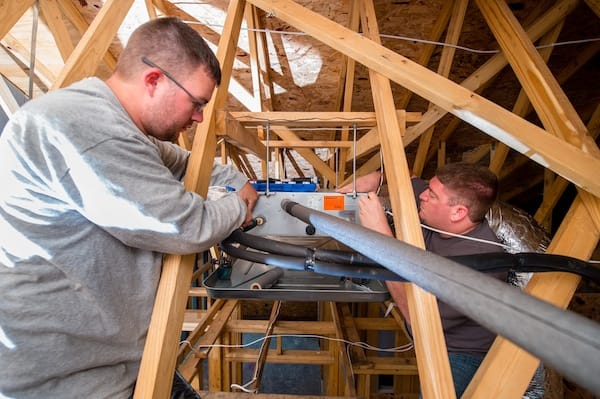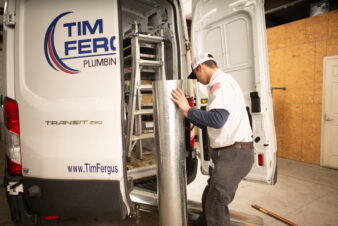As Energy Star requirements become more prevalent in affordable housing construction, everyone benefits. The challenge is raising efficiency levels without significantly increasing the cost of construction. This is especially true in a climate prone to extremes. In northern Iowa, winters are brutal and spring fades quickly to hot, humid summer.
10th Street Townhomes is a new subsidized housing development in Storm Lake, Iowa. Eight, two-story buildings contain 42 apartments, most of which are around 1,400 square feet in size. Tiny heating and cooling loads come courtesy of SIPs (structural insulated panel) construction. It helps, too, that the row-home configuration eliminates virtually half the exterior walls when compared to free-standing buildings of the same size.
A year before the project began, Southwest Minnesota Housing Partners, a non-profit that operates in several Midwestern states, hired Hawk-I Electric, Plumbing & Heating out of Storm Lake, based on the firm’s experience with similar projects. The 20-person, full-service company began 12 years ago as an electrical contractor and added plumbing and heating services in 2013.
“Our first plumbing job was at a McDonalds, and our first big HVAC job was an office in town,” said Scott Haldin, owner of Hawk-I. The company name was born of Scott’s passion for University of Iowa football. “We started hiring techs right away and we’re still hiring today.” Since then, their work has expanded to light commercial and residential, including multi-family housing.
Quick redesign
Before Haldin weighed in on the design at 10th Street Townhomes, the general contractor’s plan was to use condensing furnaces and central air conditioning. To shrink upfront and operating costs, Haldin suggested the use of mini split heat pumps instead. The project started in early 2014, and while some units are occupied, all work should be complete by the fourth quarter of this year.
Most of the two-story apartments follow the same floor-plan, with the exception of a single story configuration for handicap-accessible units on the end of each building. This expedited both the design and installation process. A single, two-ton Fujitsu Halcyon condensing unit outside serves a 12,000 BTU slim duct system upstairs and a 9,000 BTU wall-hung unit in the downstairs open floorplan.
An additional evaporator is used for the master bedroom in several four-bedroom apartments. Because of their single-story layout, the handicapped units forgo the wall-mount heads and rely entirely on slim duct.
“We couldn’t have accomplished this project cost effectively with mini-splits 15 years ago,” said Haldin. “From an efficiency and flexibility standpoint, it wouldn’t have been possible, let alone using them this far north.”
The ducted systems include an in-line heater for backup heat during the harshest days of Iowa’s heating season. Downstairs, a section of Thermolec electric baseboard is used for backup.
“I don’t think the backup elements will run often, but the mercury can drop below zero pretty easily around here,” continued Haldin. The multi-zone units used at 10th Street are mostly 23-SEER systems, but Fujitsu makes a 33-SEER, single-zone model capable of heating at outdoor temperatures as low as -15°F.
Much like on the HVAC side, Hawk-I opted for a simple and effective DHW solution. A 50-gallon Bradford White electric tank is installed in a downstairs closet. The single energy source was chosen to simplify the plan.
Train for it
Given that this isn’t Hawk-I’s first multi-family housing job, the actual installation didn’t entail any work outside the norm. Technicians completed a little additional training on the slim duct product as a refresher.
“Local support of the Fujitsu line is fantastic,” said Haldin. “For instance, as soon as I decided to present a mini-split proposal to the builder and property manager, Shawn Donovan, at Mondale & Associates wasted no time in helping me design the system.”
According to Haldin, the same goes for Johnstone Supply, in Souix City, IA. Units, line sets and accessories are readily available. Bill Hanke, territory manager at Johnstone, quickly set up the training for Hawk-I technicians with almost no notice.
For the remainder of the year, as the project draws to a close, “hurry up and wait” is the name of the game. As the general contractor completes a housing unit at 10th Street, Hawk-I technicians complete installations of the HVAC systems. Great support and training, combined with experience at multi-family installations proved to be the recipe for success.










Join the conversation: